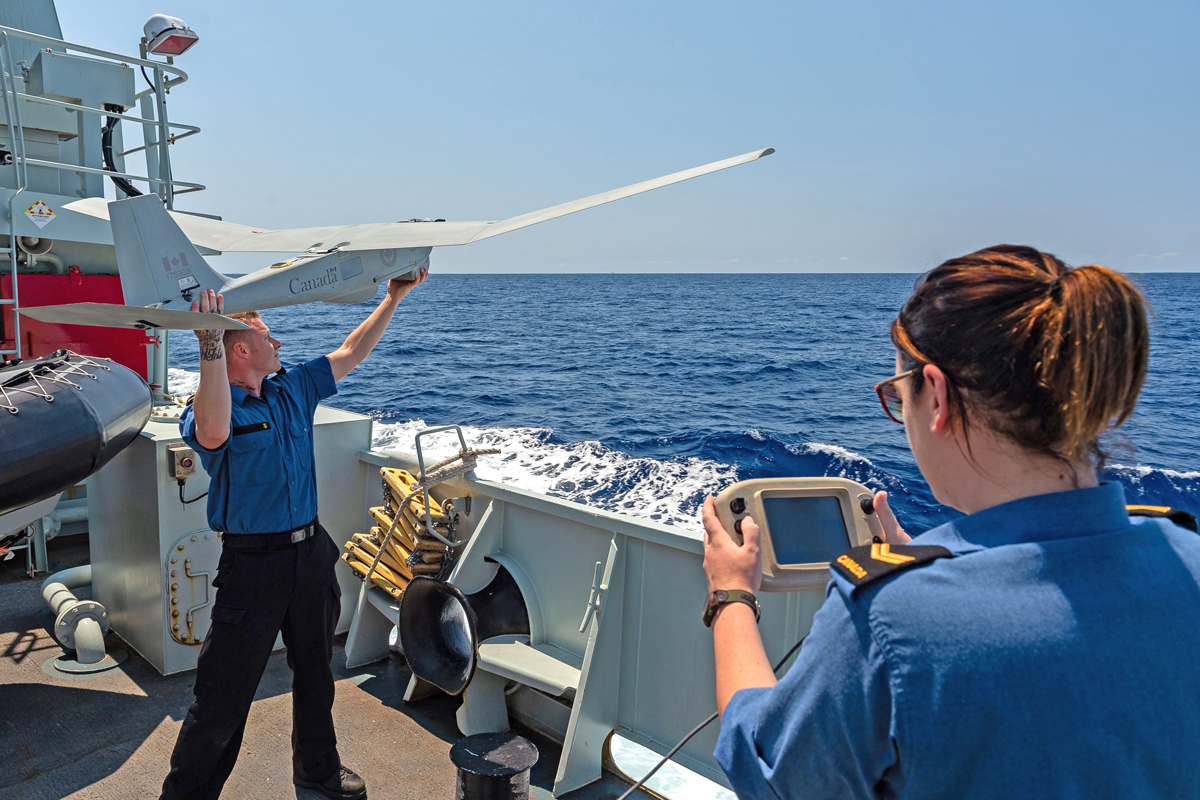From radar tech to unmanned aircraft pilot
By Lookout on Jun 14, 2020 with Comments 0

LS Myles Hunter, Unmanned Aircraft Systems Detachment Commander, holds one of the Royal Canadian Navy’s new Puma unmanned aircraft as LS Meghan Heal helps him conduct pre-flight checks on the sweep deck of HMCS Whitehorse. Photo by Corporal Nathan Moulton, Canadian Armed Forces Imagery Technician
Navy Public Affairs ~
Leading Seaman (LS) Myles Hunter joined the Royal Canadian Navy (RCN) as a radar technician because he wanted to work with cutting edge technology.
Little did he know his choice and passion would bring him to the frontier of naval innovation as one of the fleet’s first Unmanned Aircraft System (UAS) operators.
The navy has only been using unmanned aircraft (UA) for about two years and much of that time has been spent testing and observing its capabilities, said LS Hunter.
The navy is currently using Puma-model drones, which are 1.5 metres long, ghost grey and model plane-like in appearance. The Puma can be hand-launched by operators off a ship deck and then retrieved by scooping them out of the water.
LS Hunter said that the unmanned aircraft were used to scout and locate potential drug smuggling ships by HMCS Goose Bay in 2019 and more recently on HMCS Whitehorse on Operation Caribbe. When out on patrols they used Pumas to sweep an extended area around the ship, helping it stay below the horizon line and out of the line of sight of suspicious ships.
During these ‘creeping line searches’, the Puma’s altitude extends the ship’s field of view, and it can cover a 176-square-kilometre area in just two hours, said LS Hunter.
Working with intelligence often gathered from U.S. Coast Guard partners, a ship’s command team can use the unmanned aircraft to observe details of other ships — for example how much fuel or how many passengers or engines another ship is carrying — and use that information to determine if that ship is of interest.
With screens set up on the bridge and operations room of the ship, the technology allows different teams to monitor what the Puma sees via real-time streaming video while the operations of the aircraft itself are managed by only two people.
With this technology, instead of weaving around waters hunting smugglers, a patrolling ship can drive a relatively straight path and all the weaving is done by the unmanned aircraft. This saves fuel and increases operational time because the ship doesn’t need to go back to port as often. The Puma’s batteries can be recharged by plugging them in on board.
If in extended operations and the Puma’s batteries run out (it has a two to three hour flight time), it can be landed in a safe area of water and left for up to four hours before being retrieved while another Puma can continue operations, said LS Hunter
Traditionally, once it was decided to dispatch a boarding team, the ship’s command would monitor the boarding operations from a distance via radio. The Pumas now allow visual monitoring from the sky, providing greater situational awareness to the command suite. The units also have infrared capability, and in non-operational tests with divers have proven to be useful locating people who have fallen in the water at night, said LS Hunter.
“Luckily we haven’t had the opportunity to test that in real life,” he said.
LS Hunter spoke about how he got into the forefront of navy unmanned system operations.
A few years ago, “there were rumours going around that the navy was purchasing [unmanned aircraft] and that we were starting this new era of technology. Being an engineer and technician, and this being the latest, greatest thing, I wanted to be a part of it really bad. So, I got in touch unofficially with the team setting it up and just got them to know my face and showed them how ambitious I was,” he said.
LS Hunter spent the first part of this naval career as a radar technician serving aboard HMC Ships Athabaskan and Montreal, choosing that path because he wanted to get his hands on the most advanced technology possible.
Luckily for him, when the navy started looking within its ranks for UAS operators they decided that, along with naval combat information operators, they’d use radar technicians.
In 2017, LS Hunter and the other first wave of navy UAS operators began their initial training. After a year of operating the Pumas and becoming experienced with them at sea, he was moved to commanding the ship’s team as an unmanned aircraft systems detachment commander. Here he’s found himself in a working environment he’d never dreamed of being in when he first enrolled in the forces.
“Usually, I was always the nerd behind the scenes fixing the equipment. It was a crazy change,” he said.
LS Hunter said he went from being a rather regular shift worker on the ship to having to be ready 24/7 as operations work on schedules not necessarily aligned with a person’s gym, meal, or sleep times.
His new role finds him directly involved with daily ship operations. He often reports in person to the captain and has to create mission scenarios on demand and on the fly, completely from scratch. He said his new role has given him a greater appreciation for why things are done on a ship — things that seemed odd before when he wasn’t so intimately involved in command decisions.
“Operations can be more chaotic, but I love it. You have to adapt and change to the situation, but we always seem to get the job done,” he said.
LS Hunter said that he is currently part of a team that has developed and is running a new navy-specific UAS course.
“I think in the future you will see the [RCN] using unmanned aircraft systems more and more, and different types. I’m really excited about this technology,” he said.
––––
Filed Under: Top Stories
About the Author:





